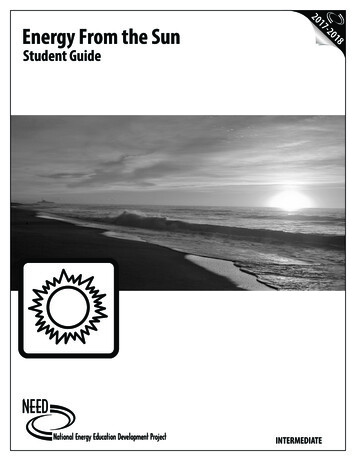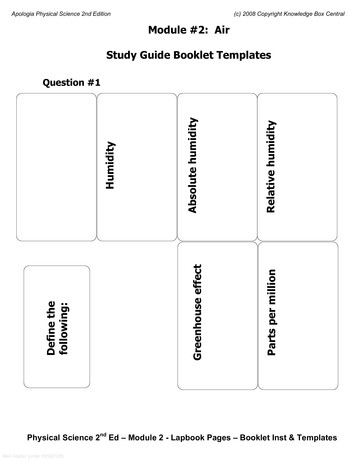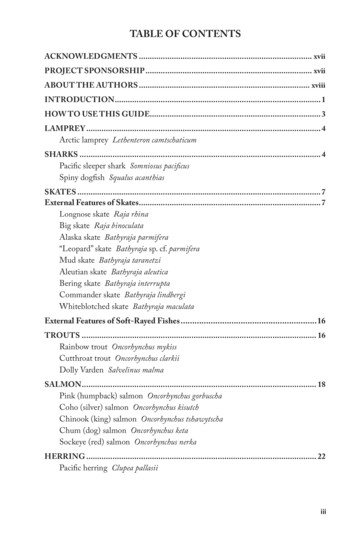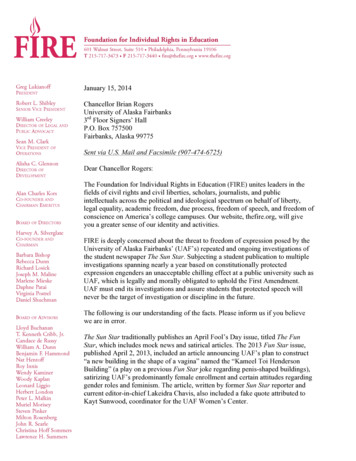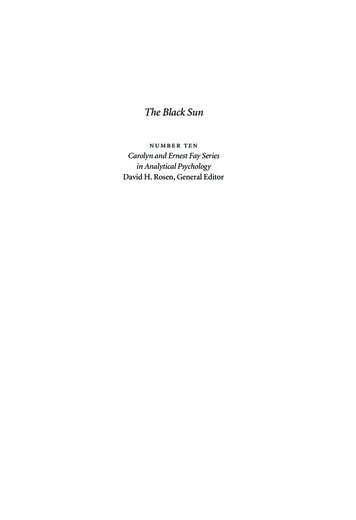
Transcription
The Black Sunn u m b er tenCarolyn and Ernest Fay Seriesin Analytical PsychologyDavid H. Rosen, General Editor
The Black Sunthe alchemyand art of darknessStanton MarlanForeword by David H. Rosentexas a&m university pressc o l l e g e s tat i o n
Copyright 2005 by Stanton MarlanManufactured in the United States of AmericaAll rights reservedFirst editionThe paper used in this book meets the minimum requirementsof the American National Standard for Permanenceof Paper for Printed Library Materials, Z39.48-1984.Binding materials have been chosen for durability.oLibrary of Congress Cataloging-in-Publication DataMarlan, Stanton.The black sun : the alchemy and art of darkness / Stanton Marlan ; foreword byDavid H. Rosen.—1st ed.p. cm. — (Carolyn and Ernest Fay series in analytical psychology ; no 10)Includes bibliographical references and index.ISBN 1-58544-425-1 (cloth : alk. paper)1. Jungian psychology. 2. Alchemy—Psychological aspects.3. Shadow (Psychoanalysis). 4. Self. I. Title. II. Series.BF175.M28345 2005150.19'54—dc222004021663
I dedicate this book to my wife, Jan;my children, Dawn, Tori, and Brandon;my grandchildren, Malachi and Sasha;and to my father Jack and my mother Sylvia.I also dedicate this book to my patients and toothers who have suffered an encounter with theblack sun, and I hope that they may also cometo know something of Sol niger’s shine and thebenevolence of darkness.
contentsSeries Editor’s Foreword, by David H. Rosen ixAcknowledgments xvIntroduction 3chap ter 1The Dark Side of Lightchap ter 2The Descent into Darkness927chap ter 3Analysis and the Art of Darkness 65chap ter 4Lumen Naturae: The Light of Darkness Itself 97chap ter 5The Black Sun: Archetypal Image of the Non-Self 148Epilogue 211Notes 215Bibliography 237Index 249
forewordDavid H. RosenAs far as we can discern, the sole purpose of humanexistence is to kindle a light in the darkness of merebeing.—C. G. JungNearly six months before Stan Marlan’s superb 2003 Fay Lecture series on the black sun, I had this dream: There was too much light andbrightness everywhere. I gave a talk on the need for darkness and itshealing value. I said I could always leave Star, a town at the periphery.I realized that I could break off and leave and go to the Texas hill country and write haiku.The dream is about enantiodromia and the restorative necessity ofdarkness and its nurturing solitude. I became aware that I could leaveStar (a constant source of light) and end up alone in the Texas hill country writing haiku. This breaking off and leaving is what I call egocide(symbolic death), which leads to transformation (rebirth) throughcreativity.1The black sun and the alchemy and art of darkness are subjects dearto my heart and soul.2 When I was in a psychic black hole contemplating suicide thirty-five years ago, my own darkness went through an alchemical process involving art.3 I was able to transcend my despair andlater transform my depression, healing my soul through creativity. Artis healing, and the shadow of despair is the fuel for creativity. Darknessis critically needed in our too-well-lighted world. As Stan Marlan out-
lines in this important book, the secret is to engage in the alchemy andart of darkness, which yields creative endeavors through Jung’s technique of active imagination. Usually I do this through painting andwriting, most recently by completing a book on The Healing Spirit ofHaiku.4Given my experience with and affinity for darkness, I eagerly readMarlan’s Black Sun, which explores darkness in vast and deep ways.Irvin Yalom states, “Everyone—and that includes therapists as well aspatients—is destined to experience not only the exhilaration of life,but also its inevitable darkness: disillusionment, aging, illness, isolation, loss, meaninglessness, painful choices, and death.”5 Yalom alsostates that there is an “inbuilt despair in the life of every self-consciousindividual.”6In the deep dark the person alone sees light.—Chuang Tzu 7In the introduction, Marlan says that the black sun became a Zenkoan for him. This got me thinking about the time I spent in Japan andthe fact that in the Shinto religion the sun is considered a goddess. Inother words, a black (yin) sun that glows and inspires creative works isSol niger (black sun) functioning as a muse. Thus, in the land wheredarkness is praised, fear of the dark is overcome, and the black sun is acreative fire that heals.8 Most striking—and a testament of the truth ofan inner shine of darkness—is that blind people see light in their darkinterior.In chapter 1 Marlan begins with a focus on the sun as the source oflight and its association with the King (a divine archetype). He givesseveral excellent alchemical examples of how the King must die in order to be born again. Closer to home, Elvis Presley, America’s “King,”illustrates the theme of this book in that he represents a dark King. Hegot stuck in the nigredo (darkness) and was poisoned. However, afterElvis died he continued to live on, reborn as a dark or blue King withan inner spiritual glow.9In chapter 2 we descend with Marlan into the darkness and see thenecessity of experiencing one’s own “dark night of the soul.” A case of(x)Series Editor’s Foreword
a troubled woman is presented, which includes dramatic illustrationsof the black sun. Her image of an “exploding black sun” is associatedwith “the madness of her suicidal feelings.” It may also have foretoldan aneurysm in the anterior region of her brain. She survived thisnear-death experience but lost sight in one eye. This case underscoresthe danger involved in getting close to the black sun. Marlan presentsanother case, also of a woman in long-term analysis who creativelytransforms her suicidal feelings based on contact with the black sun.This patient’s words and drawings are profound, and Marlan links thedeep, dark work to powerful archetypal images from art, religion, andliterature.Chapter 3 outlines how analysis (breaking apart) is like the alchemical processes of mortificatio and putrefaction. Marlan describes brilliantly—and reveals through his alchemical psychological approach—how analyzing the ego to death opens the psyche to creative transformations involving the deep art of darkness. In essence, Marlan showsus how darkness heals by shining through.In chapter 4 Marlan focuses on Jewish mysticism (primarily thekabbalah), Taoist alchemy, and illuminating pictures from artists andpatients. Through these it becomes clear that darkness itself glows witha unique spiritual light. Marlan humbles us before a myriad of glimpsesof Sol niger.The last chapter concerns the mystery of Self and non-Self as Oneor Not-One. I think his position would be acceptable to both Lao Tzuand Jung, although Jung was more comfortable with the dark side ofthe Self rather than non-Self. For Jungian analysts who are Buddhists,such as Polly Young-Eisendrath, the paradox of Self and non-Self makesparticular sense.10 Jungian analysts who are Taoist in their spiritualorientation are also content with the irony of opposites: nothingness/fullness, dark/light, and evil/good.11 Why? Because it is impossible toknow one without the other. Transcendence of these opposites allowsfor the possibility of wholeness and emptiness. And, as we often see inthis book, transformation of the opposites allows for creative art andhealing.In the epilogue, Marlan distills the essence of the journey he hastaken us on from light to darkness and then to the light of darkness itSeries Editor’s Foreword (xi)
self. I wholeheartedly support Marlan’s maxim of preserving the mystery of Self and non-Self as a paradox. In the end it is both/and. LikeVictor Hugo’s last words, we see “black light”:Seeing into darkness is clarity.Knowing how to yield is strength.Use your own light and return to the source of light.This is called practicing eternity.—Lao Tzu12This volume helps us to understand the source of archetypal darkness and its relationship to a psychic crisis involving the black sun. Aswe know from Chinese philosophy, crisis involves both danger andopportunity. It is noteworthy that dreams of a black sun or an archetypal abyss can be both a warning of psychic and/or physical demise aswell as the beginning of a significant renewal.In alchemy the nigredo is first, and, according to Plato, the beginning is the most important part of the work. I agree with Marlan thatdarkness has neither been seen as primary nor valued for its inherenthealing power and creative transformation.13 The opportunity forhealing through the art of darkness is ever present and extremely wellillustrated in the text.Another example of the alchemy and art of darkness as well as egocide and transformation is William Styron’s eloquent memoir, Darkness Visible.14 It is a book about his fall into a suicidal void and hisstruggle to climb out. Most likely he was guided by a healing glow coming from Sol niger.On May 15, 2003, while I was editing this manuscript, there was aluna niger, a total eclipse of the moon by the sun’s shadow. Marlanwrites about the shadow of the sun and its darkness, and where is thismore apparent than in a total eclipse of the moon? Perhaps in our timethis represents the patriarchal Sun King and its shadow, which eclipsesthe feminine, whereas the black sun has no need to eclipse the moonbecause both have a soft glow, one from within and the other fromouter reflection.(xii)Series Editor’s Foreword
To conclude, this volume is extraordinary in its breadth and depthand in its objective and subjective scope. Stan Marlan’s method of illustrating the alchemy and art of darkness with clinical cases, drawings, and paintings is rare and truly phenomenal. Clearly this book willenrich us all.I close with the poet Wendell Berry’s words, which seem connectedto Sol niger:To go in the dark with a light is to know the light. To know thedark, go dark. Go without sight, and find that the dark, too,blooms and sings, and is traveled by dark feet and dark wings.15Notes1.D. H. Rosen, Transforming Depression: Healing the Soul through Creativity(York Beach, Me.: Nicolas-Hays, 2002), pp. xxi, xxiv, xxv–xxvi, and 61–84.2.Ibid.3.Ibid., pp. xvii–xxii.4.The Healing Spirit of Haiku is coauthored with Joel Weishaus and illustratedby Arthur Okamura.5.I. Yalom, The Gift of Therapy (New York: HarperCollins, 2002), p. 6.6.Ibid., p. 7.7.Chuang Tzu, “Readings from Chuang Tzu,” in T. Merton’s The Way ofChuang Tzu (Boston: Shambala, 1992), p. 147.8.J. Tanizaki, In Praise of Shadows (New York: Leete’s Island Books, 1998).9.D. H. Rosen, The Tao of Elvis (San Diego: Harcourt, 2002).10. P. Young-Eisendrath and S. Muramoto, eds. Awakening and Insight: ZenBuddhism and Psychotherapy (New York: Brunner-Routledge, 2003).11.Rosen, The Tao of Jung: The Way of Integrity (New York: Penguin Arkana,1997).12. Laozi, Tao Te Ching, trans. S. Mitchell (New York: HarperCollins, 1988),p. 52.13.Rosen, Transforming Depression.14. W. Styron, Darkness Visible (New York: Random House, 1990).15.M. Oman, ed., Prayers for Healing: 365 Blessings, Poems, and Meditationsfrom around the World (Berkeley: Conari Press, 1997), p. 254.Series Editor’s Foreword (xiii)
acknowled g mentsI am deeply indebted to David Rosen and Carolyn Fay for choosing meas a Fay lecturer and for giving me the opportunity to present my ideasat Texas A&M University. David was a superb guide through the entireprocess and an impeccable host during my stay at College Station. Inaddition, I am indebted to him for both his astute editorial suggestionsand for his own scholarly work, which became important in my ownreflection. In David I have found a fellow traveler into the depths ofdarkness.In addition, I am indebted to many people who have played an important role in making and are a living part of the final product. Manymentors, both living and dead, colleagues, analysands, patients, students, friends, analytic and academic organizations, and family members have contributed to my writing and research in numerous ways.The final product is my own, but it would not have been possible without the ongoing engagement and generosity of others.The work of C. G. Jung has been an essential foundation for thesereflections. His contributions to a psychological approach to alchemyinform a sustaining passion and continuing impetus for my own workwith the difficult and arcane materials of alchemy.I am also indebted to Marie-Louise von Franz, Edward Edinger, andJames Hillman, all of whom have made significant contributions to thecontinuation and development of Jung’s work and therefore have playedan essential role in the development of my ideas about the black sun.I give special acknowledgment to Edinger and Hillman, who wereboth my analysts. Edinger’s deep reflections on alchemical themes wereessential in my development as an analyst. His early lectures, teachings, and writings, particularly in Anatomy of the Psyche, filled my
heart and soul as I wrote. Likewise, Hillman’s work has been formativeand inspiring. His originality and critique of traditional ways of thinking put alchemical psychology on a new trajectory, reversing a tendency to reduce alchemical images to psychological constructs. Overthe years as analyst, teacher, and later as colleague and friend, he hasbeen a central influence in the formation of my ideas and the development of my imaginal life. I also want to thank my former analyst Anneliese Pontius, whose encouragement and faith in me first set me onthe path to becoming an analyst, and to Harriet Machtiger, who madeit possible to complete my training in Pittsburgh. I owe a debt of gratitude to my former analyst and now colleague and friend Thomas Kapacinskas for his years of deep insight, challenge, and support andwhose depth of heart has been an essential ingredient in the development of the stamina necessary to engage the darkness of Sol niger.I have also benefitted from the scholarly work and friendship ofmany gifted Jungian colleagues. I cannot mention them all, but I wishto thank my good friends James Hollis, Lyn Cowan, and Pat Berry, whohave often offered their guidance when I found myself directionlessand kept me in good humor as I descended into darkness. I also owe adebt of thanks to my good friend and colleague Maurice Krasnow,whose excellent critique of an early paper on the black sun opened newavenues for the furthering of my ideas. Thanks also go to my dearfriends and colleagues Vocata George and Dianne Braden for theirlong-time support of my work and for the pleasure of our long talksabout darkness and the life of the soul. I also thank Vocata for reminding me of the importance of the work of Anselm Kiefer, whose art resonates so strongly with my vision of the black sun.I am also grateful to my good friends and colleagues Paul Kugler,David Miller, Wolfgang Giegerich, Robert Romanyshyn, Sonu Shamdasani, Ron Schenk, and David Perry, all of whom have inspired mywriting over the years of our valuable friendship.I would also like to thank Murray Stein, a friend and colleague whoread an earlier paper on Sol niger and has made many supportive gestures over the years. He provided an opportunity for me to publish Firein the Stone: The Alchemy of Desire and enabled me to present my workon Taoist alchemy in China.(xvi)Acknowledgments
I also acknowledge my appreciation of my old friend DonaldKalsched, with whom I began my training when we were students atthe New York Institute. Don’s current work on the defenses of the Selfhas been important in the formulation of my thinking about the blacksun.Thanks likewise go to my colleagues Brian Skea and Roger Brookefor their support and friendship over the years. Roger made it possiblefor me to present my work at Duquesne University. His Jung and Phenomenology has helped to clarify my own ideas.I owe a debt of gratitude to kabbalistic scholar, philosopher, andpsychologist Sanford Drob, whose wonderful support and critique ofmy work opened many new directions. I am also grateful to BitzalelMalamid, who selflessly shared an untranslated Chasidic/kabbalistictext that richly amplified my understanding of black light. He has trulybeen a teacher to me though he insists we are simply learning together.I likewise wish to thank alchemical scholar and my friend AdamMcLean for his guidance and recommendations of research materialsand for introducing me to the wonderful collection of alchemical textsand manuscripts at Glasgow University during my visit to Scotland.Thanks also go to alchemical teacher and scholar Dennis Hauck, fromwhom I have learned a great deal about the practical aspects of alchemy and its importance in the overall work of the alchemical opus.I want to extend my heartfelt appreciation to those who have contributed materials for my research. Over the years, many people havegenerously shared their knowledge, ideas, references, and drawings, allof which have immeasurably enriched this book. To name all of theparticular contributions would far exceed the format of these acknowledgments, but I wish to extend my sincere gratitude to Harry Wilmer,Marga Speicher, Michael Adams, Peter Thompson, Anu Kumar, JaniceMarkowitz, Suzanne Bailey, Tim Pilgrim, Dennis Charier-Adams,Thomas Hart, and Tyler Dudley.Special thanks go to my good friends Lynne Connoy for her impressive artwork and to Keith Knecht, who has been so generous withhis knowledge and talents.I would like to express my appreciation to artist and friend JanetTobin for inviting me to lecture on alchemy to her colleagues and forAcknowledgments(xvii)
contributing her powerful black painting to this book. My deep appreciation goes out to artist Virginia Moore, who likewise has beengenerous in supporting my work and whose impressive art inspiredmany discoveries about the black sun.In addition, I owe a debt of gratitude to my philosophical teachers,colleagues, and friends at Duquesne University. Thanks go first tophilosopher Monique Roelofs for reading an early draft of my paperon the black sun. I appreciate her challenges, comments, and the richdialogue that flowered into an important friendship. I also wish to express my thanks to my friend Bettina Bergo, Levinas scholar and translator, for her spontaneous generosity and astute, on-the-spot editorialsuggestions. Thanks also go to Wilhelm Wurzer, chairperson of thephilosophy department at Duquesne University, who read an earlyreflection on the black sun and who entered into many enjoyable discussions with me of Goethe’s Faust and darkness.Thanks go to my friend John Schulman—poet, bookseller extraordinaire, and owner of Caliban Books—who has continually gone outof his way to find and recommend obscure works and references on theblack sun.I am also grateful to Mark Kelly, librarian at the Pacifica Graduate Institute, for his help with references and to Maureen Porcelli and PatriciaSohl for locating many dramatic images from the ARAS collection.I am indebted to both Claudette Kulkarni, friend, colleague, andfeminist Jungian scholar who read my entire manuscript and madevaluable suggestions. In addition, Claudette Kulkarni and Ravi Kulkarni both worked tirelessly to track down and obtain the many necessary permissions for the illustrations published here. I am deeply intheir debt. Thanks also to Sharon Broll, whose professional editinghelped to put my manuscript in its best possible form.I give very special thanks to Bill Blais, without whose assistance, patience, skill, and scholarship I would have never completed the book.Bill, a graduate student in psychology at Duquesne University, was referred to me as an assistant and typist with computer skills. In all ofthese functions he proved invaluable, and it wasn’t long before he became an intellectual partner and friend. He knows the book as well asI do and made many suggestions that I have incorporated into the text.(xviii)Acknowledgments
I give special thanks to my very closest friends, Susan and Terry Pulver, whose companionship over the years and during the writing ofthis book have been sustaining and nourishing. Terry, a Lacanian psychologist and faithful lover of psychoanalysis, has been a consistent intellectual partner and confidante. Our exchanges over the years onLacan, Jung, and postmodernism have influenced me greatly. I amdeeply indebted to him for his contributions to my thought.I want to thank the Inter-Regional Society of Jungian Analysts, theC. G. Jung Institute Analyst Training Program of Pittsburgh, the Pacifica Graduate Institute, Duquesne University, and Texas A&M for theirsupport of my work and for giving me the opportunity to lecture onthe black sun.I cannot end these acknowledgments without my heartfelt thanksand gratitude to my family: my wife, Jan; my daughters, Dawn andTori; my son, Brandon; my son-in-law, Jeff Librett; my grandchildren,Malachi and Sasha; my father, Jack; my late mother, Sylvia; and mybrother, David. I treasure their love, support, and interest far morethan I can express.My fatherly love and pride are immeasurable, and I am grateful tomy children, who in their own ways have materially contributed to thisbook: Thanks go to Dawn for her sensitive support, her astute critiqueof what’s left of my Jungian essentialism, and her and Jeff ’s scholarlyresponses to my questions about French and German translation.Thanks go to Tori for her kindness and for her examples of courageousresearch, fair mindedness, and editorial excellence. Thanks go toBrandon for his indomitable spirit, for keeping me in touch with thesoul of music, and for his recommendation of the art of Alex Grey as itpertains to my work.I end with my deep gratitude to my wife and Jungian colleague, JanDeVeber Marlan, who has been my companion along the way. She hasnot only offered her support in innumerable ways but has also beenmy best critic, friend, and intellectual partner. Without her this workwould never have seen the light of Sol niger.Acknowledgments(xix)
The Black Sun
int ro duc t ionI first became aware of the image of the black sun while reading Jung’salchemical works and later in a more personal way in my analysis of awoman whose encounter with the black sun was dramatic and lifechanging. What I initially thought was a rare and obscure phenomenon proved to be far more widespread than I had imagined. I havesince found it to be linked to the deepest issues of our mortality and toboth tragic and ecstatic possibilities.The groundwork of my fascination with the black sun was laiddown long ago—in childhood. I remember thinking about death, realizing that I would die along with everyone and everything I loved andvalued. My thoughts about mortality took on an obsessive quality, andI wondered why not everyone spent all of their time trying to solve theproblem of dying. Over the years I learned much about the historicaland psychodynamic reasons for my obsessions, and even though theissue of personal mortality no longer aroused in me the same level ofanxiety, I still struggled to find a stance in regard to this inescapableand existential truth of life.I once had a dream of floating on a raft moving toward a waterfall.I was standing with my back to the direction of the flow but was bentover in order to see where the raft was going. I could see that it wouldat some point fall over a precipice, which would mean certain death. Iheard a voice say, “Yes, you are going to die, but you don’t have to bendover backward to see it.” While the truth and humor of this dream gaveme some relief from my obsession, I never quite stood up completelystraight again.My reflective turn toward death marks my melancholic characterand, like the historical alchemist who has a skull on his bench as a me-
mento mori, concern with mortality remains a part of my psychic reality. I now believe that these concerns prepared the way for my engagement with the black sun, a dark and burning ball of fire, an intensity ofdarkness and light that became like a Zen koan to me.The Mumonkan, a classic collection of Zen koans gathered by thethirteenth-century, Chinese Zen master Mumon, speaks of the inescapability of the koan. It is like swallowing a red-hot iron ball thatyou cannot actively expel. However, you cannot passively leave it insideyou either, or it will kill you. The Mumonkan describes the situation asone in which one’s whole being has been plunged into great doubt.All of one’s emotions are exhausted; one’s intellect has come to extremity. Rinzai, a well-known, ninth-century Chinese Zen master, once described this state as the whole universe plunged into darkness.1 Thisdescription fits my relationship with the black sun. Over the years spentin writing this book, I have taken in this black sun like a red-hot ironball that I have been unable to expel. It has become not only my darkkoan but also an enigmatic and infernal light referred to in alchemy asSol niger.Sol niger is an image that Jung wrote about in his late works onalchemy, and though it played a relatively marginal role in his reflections, I have found its implications to merit a far more extensive exploration. This image has shown itself in relation to the darkest andmost destructive situations, in what the alchemists have called theblacker-than-black dimensions of the nigredo. The term nigredo is usually thought of as a beginning process in alchemy, roughly equivalentto a descent into the unconscious. In the face of this darkness and thesuffering that sometimes accompanies it, there is a natural tendency toturn away from the psyche. While this defensive process is at timesnecessary, it may also inhibit or bypass a hidden potential in the darkness itself. The dark side of psychic life is both dangerous and at timestragic, but the acceptance of its tragic potential was for Jung a necessity. He noted that the cure for suffering might well be more suffering.In the Visions Seminar of 1933, a participant, Dr. Baker, commentedon Jung’s ideas and offered the group a passage from Miguel de Unamuno’s book The Tragic Sense of Life:(4)Introduction
The cure for suffering—which is the collision of consciousnesswith unconsciousness—is not to be submerged in unconsciousness, but to be raised to consciousness and to suffer more. Theevil of suffering is cured by more suffering, by higher suffering.Do not take opium, but put salt and vinegar in the soul’s wound,for when you sleep and no longer feel the suffering, you are not.And to be, that is imperative. Do not then close your eyes to theagonizing Sphinx, but look her in the face, and let her seize youin her mouth, and crunch you with her hundred thousand poisonous teeth, and swallow you. And when she has swallowedyou, you will know the sweetness of the taste of suffering.2There will be little opium and plenty of salt and vinegar as we beginour descent into darkness. Nevertheless, you may also find some surprises as we follow Sol niger in clinical practice and through myth, literature, the creative arts, and various traditions at once philosophical,religious, and mystical. The black sun is a paradox. It is blacker thanblack, but it also shines with a dark luminescence that opens the wayto some of the most numinous aspects of psychic life. It proffers a miracle of perception at the heart of what Jung called the mysterium coniunctionis. Considering the complexity of Sol niger will give us an opportunity to consider Jung’s idea of the Self in a new way—one thatboth critiques and preserves its integrity as a central mystery of thepsyche, which for Jung was always fundamental.In chapter one we set the stage for our exploration by discussing theprimacy of light as a metaphor for consciousness. We then consider theimportance of the alchemical deconstruction of this light, which prepares us for our descent into the unconscious. There is a lot of darkmaterial, and the descent is difficult and painful. In chapter two we follow a path, not from darkness into light, but from light into darknessand into the shine of darkness itself. Beginning with Goethe’s Faust, welook at a series of vignettes—literary and clinical—in which the blacksun appears and becomes important. These illustrations lead to theblacker-than-black aspects of Sol niger, and these serve as the foundation for our ongoing exploration.Introduction(5)
The third chapter, titled “Analysis and the Art of Darkness,” looks atthe issue of trauma as one response to Sol niger. We examine some ofJungian analyst Don Kalsched’s contributions to this theme from hiswork, The Inner World of Trauma, particularly the idea of the defensesof the Self as an archetypal process protecting the Self from disintegration. My reflection on the black sun explores a different perspectivewith regard to the archetypal functioning of psychological life. If wecan for a moment project human intention onto the dark forces thatattack the psyche, I believe their aim is not always to protect but ratherto mortify the Self and to drive it into the unthinkable, which the ideaof archetypal defense seeks to avoid. In this light we also look at thecontribution of Jungian analyst David Rosen to this theme in his bookTransforming Depression and his idea of egocide and the strange confluence of death and new life. From my perspective, this theme ofrenewal does not follow simply from symbolic death but is actuallyfundamental and at the core of Sol niger, which expresses itself in thesimultaneity of blackness and luminescence, the central mystery of theblack sun.We then amplify this imagery by turning to the world of art andparticularly to painters who have spent parts of their careers paintingblack suns and/or a kind of luminescent blackness. We look briefly atthe works of Max Ernst, Mark Rothko, Ad Reinhardt, Pierre Soulage,and Anselm Kiefer and place their discoveries in the alchemical context of the lumen naturae, the dark light of nature. For the alchemists,the lumen naturae is a different kind of light that shines at the core ofmatter and within the ancient idea of the subtle or illumin
To go in the dark with a light is to know the light. To know the dark, go dark. Go without sight, and find that the dark, too, blooms and sings, and is traveled by dark feet and dark wings. 15 Notes 1. D. H. Rosen, Transforming Depression: Healing the Soul through Creativity (York Beach, M





